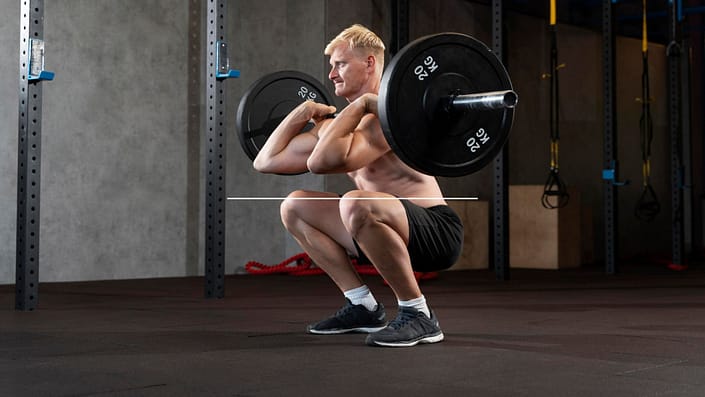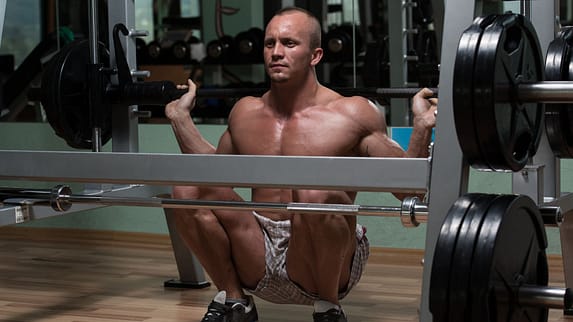That said, there are squat variations that can involve the psoas major to a greater extent:
Table of Contents
Toggle1. Front Squats
Front squats inherently demand a more upright torso position, which can increase the engagement of the psoas major. Placing the barbell in front of your body, resting on your shoulders, shifts the center of gravity forward. To maintain balance, your body relies more on the hip flexors, including the psoas major.

2. Deep Squats
Deep squats, where you lower your body below parallel, can also engage the psoas major to a greater extent. Descending deeper in a squat requires more hip flexion, which involves the psoas major and other hip flexor muscles to a higher degree.

3. Single-Leg Variations
Unilateral exercises like single-leg squats or lunges can engage the psoas major more because they require greater stabilization and balance. The psoas major works harder to stabilize the pelvis during these movements.

While these variations can involve the psoas major to a greater extent, it’s important to note that squatting alone might not fully isolate this muscle. Targeted exercises like hip flexor stretches or specific psoas-focused movements might be necessary for direct activation and strengthening.
For a comprehensive workout targeting the psoas major and overall lower body strength, a combination of squats with supplementary exercises like lunges, leg raises, or specific hip flexor stretches can be highly effective.
Importance of Psoas Major Engagement in Squats
While the psoas major isn’t the primary muscle targeted during squats, its engagement is crucial for maintaining proper form and overall lower body strength. Here’s why:
Stability and Posture
The psoas major connects the spine to the lower body, aiding in stabilizing the spine and pelvis during movement. Engaging it during squats helps maintain proper posture and prevents excessive forward leaning or arching of the lower back.
Range of Motion
Activating the psoas major allows for better hip flexion, facilitating a deeper squat. This increased range of motion not only challenges the muscles more but also enhances flexibility in the hips and lower body.
Injury Prevention
A well-engaged psoas major contributes to balanced muscle development around the hips and lower back, reducing the risk of injuries caused by muscle imbalances or improper form during squatting exercises.
Tips for Engaging the Psoas Major in Squats
Focus on Form: Ensure proper squat form, maintaining an upright torso and avoiding excessive forward lean, which can minimize psoas engagement.
Mind-Muscle Connection: Be mindful of engaging the core and consciously activating the hip flexors, including the psoas major, throughout the squat movement.
Depth and Control: Descend into the squat gradually and aim for a full range of motion without compromising form. This encourages greater involvement of the psoas major.
Variety in Training: Incorporate different squat variations mentioned earlier, such as front squats or unilateral exercises, to diversify muscle engagement, including the psoas major.
Supplementary Exercises: Include specific psoas stretches or mobility exercises in your routine to directly target and strengthen this muscle.
Conclusion
While squats are excellent for developing lower body strength and engaging various muscle groups, including the psoas major to a greater extent requires specific variations and focused activation. Incorporating a well-rounded workout routine that includes targeted exercises along with squats can help maximize the engagement of the psoas major for overall lower body strength, stability, and injury prevention.
Remember, always prioritize proper form and consult with a fitness professional if you have any concerns about your exercise routine.
Feel free to explore the provided resources for more detailed guidance and exercises targeting the psoas major and overall lower body strength.
Resources:
American Council on Exercise – Front Squat Technique
Comparison tabular
Here’s a comparison table highlighting the key points regarding different squat variations and their impact on engaging the psoas major:
| Squat Variation | Description | Psoas Major Engagement | Benefits |
|---|---|---|---|
| Front Squats | Barbell rests in front of the body, demanding an upright torso. | Engages the psoas major due to the forward center of gravity. | Promotes better posture, increased psoas engagement, and challenges core stability. |
| Deep Squats | Lowering the body below parallel, requiring more hip flexion. | Involves the psoas major to a greater extent due to increased hip flexion. | Enhances flexibility, challenges muscles through a wider range of motion, and engages the psoas major for deeper squatting. |
| Single-Leg Variations | Unilateral exercises like single-leg squats or lunges. | Requires greater stabilization and balance, engaging the psoas major for stability. | Improves balance, targets the psoas major for stabilization, and challenges muscles individually for a balanced workout. |
Each variation offers unique benefits, but all contribute to engaging the psoas major to some extent. Incorporating these variations into your workout routine can diversify muscle engagement and help target the psoas major for improved lower body strength, stability, and flexibility.
Remember, while these squats engage the psoas major, a holistic approach including targeted exercises and maintaining proper form is crucial for overall muscle development and injury prevention.
Wrapping up
Engaging the psoas major during squats can be enhanced through variations like front squats, deep squats, and single-leg exercises. While these variations involve the psoas to a greater extent, squats primarily target larger muscle groups like the quadriceps, glutes, and hamstrings.
Remember, the psoas major isn’t the sole focus during squats; it plays a supportive role in maintaining stability, posture, and aiding in hip flexion. For a well-rounded lower body workout, incorporating different squat variations alongside targeted exercises for the psoas major and maintaining proper form are key.
Explore these variations, focus on form, and consider supplementing your routine with exercises specifically targeting the psoas major. Balancing your workout regimen can lead to overall improved strength, stability, and flexibility while minimizing the risk of injury.
By understanding the role of the psoas major in squats and employing a diverse workout routine, you can optimize your lower body strength and enhance your fitness journey. Always prioritize proper form and listen to your body’s cues to achieve the best results in your fitness endeavors.

Hey there, it’s Mike Rrsq, the Editor-in-Chief over at Jsquat.com, and I’m absolutely obsessed with all things squat fitness! I’ve been lucky enough to get some serious recognition for my work in this field. With a solid background in the fitness and wellness industry, I’ve been there right from the get-go, helping shape this website into what it is today.
You see, I’m not just the boss around here; I’m also a passionate contributor. I love sharing my insights through my articles, and trust me, they’re not your run-of-the-mill stuff. Each piece I write is a labor of love, filled with my expertise and real-world experience in the fitness universe. So, if you’re into fitness and looking for some inspiration, you’re in the right place!
Related Posts
- Best 3 most effective squat variations you need for targeting the adductor magnus.
Squat is one of the most effective exercises that you can do to target quads…
- The 3 most effective squat variations you need to do for targeting the biceps femoris.
When it comes to strengthening and targeting the biceps femoris, a key muscle in the…
- Best 3 Squat Variations that you need for Targeting the Vastus Intermedius
When it comes to sculpting and strengthening the lower body, incorporating various squat variations can…
- Are Squats Without Weight Effective? (Explained)
Are you wondering if squats without weight are worth your time? Learn the benefits and…
- Why is squat more effective than Leg Press? (Explained)
If you're looking to build leg strength and muscle mass, you've probably wondered which…
- Beat 3 squat patterns you need for targeting the semitendinosus and semimembranosus muscles
Squats are a cornerstone of strength training, engaging various muscle groups across the lower body.…
- 3 most effective squat styles everyone should try out for targeting the piriformis muscle.
Squats are a powerhouse when it comes to leg workouts, engaging various muscles simultaneously. However,…
- Best 6 squat Patterns you need to do for targeting the vastus lateralis?
Targeting the vastus lateralis, one of the quadriceps muscles, involves specific squat variations. To zero…

